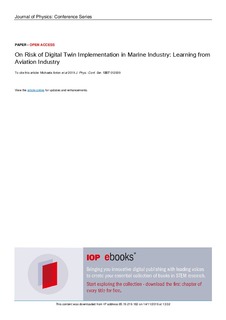| dc.contributor.author | Ibrion, Mihaela | |
| dc.contributor.author | Paltrinieri, Nicola | |
| dc.contributor.author | Rasekhi Nejad, Amir | |
| dc.date.accessioned | 2019-11-18T11:10:37Z | |
| dc.date.available | 2019-11-18T11:10:37Z | |
| dc.date.created | 2019-11-14T21:06:59Z | |
| dc.date.issued | 2019 | |
| dc.identifier.citation | Journal of Physics: Conference Series. 2019, 1357 . | nb_NO |
| dc.identifier.issn | 1742-6588 | |
| dc.identifier.uri | http://hdl.handle.net/11250/2628981 | |
| dc.description.abstract | This paper presents some aspects of the risk and challenges associated with digital twin implementation in the marine industry by learning from the aviation industry where the digital twin is more widely employed. The digital twin applications in aviation and marine industries are presented and the main steps of developing a digital twin are discussed. The three main steps of sensors (measurements), model, and data analysis are identified and used in the study. The lessons from two recent accidents in the aviation industry (Boeing 737 MAX crashes in Indonesia and Ethiopia in 2018 and 2019) are studied in details and discussed. It was found that the sensor reliability, model failure and wrong decisions as the output of the data processing are among the risks associated with digital twin implementations. In particular, from the case study accidents, it was found that the digital twin may not be able to represent all the possible scenarios which a system may experience in its life time. The digital twin presents many advantages, however the implementation of the digital twin is associated with risk and high uncertainties, even in the industries like the aviation industry, where the digital twin is well established and at a higher advanced level than in the marine industry. | nb_NO |
| dc.language.iso | eng | nb_NO |
| dc.publisher | IOP Publishing | nb_NO |
| dc.rights | Navngivelse 4.0 Internasjonal | * |
| dc.rights.uri | http://creativecommons.org/licenses/by/4.0/deed.no | * |
| dc.title | On Risk of Digital Twin Implementation in Marine Industry: Learning from Aviation Industry | nb_NO |
| dc.type | Journal article | nb_NO |
| dc.type | Peer reviewed | nb_NO |
| dc.description.version | publishedVersion | nb_NO |
| dc.source.pagenumber | 12 | nb_NO |
| dc.source.volume | 1357 | nb_NO |
| dc.source.journal | Journal of Physics: Conference Series | nb_NO |
| dc.identifier.doi | 10.1088/1742-6596/1357/1/012009 | |
| dc.identifier.cristin | 1747782 | |
| dc.description.localcode | Content from this work may be used under the terms of the Creative Commons Attribution 3.0 licence. Any further distribution of this work must maintain attribution to the author(s) and the title of the work, journal citation and DOI. | nb_NO |
| cristin.unitcode | 194,64,92,0 | |
| cristin.unitcode | 194,64,20,0 | |
| cristin.unitname | Institutt for maskinteknikk og produksjon | |
| cristin.unitname | Institutt for marin teknikk | |
| cristin.ispublished | true | |
| cristin.fulltext | original | |
| cristin.qualitycode | 1 | |

